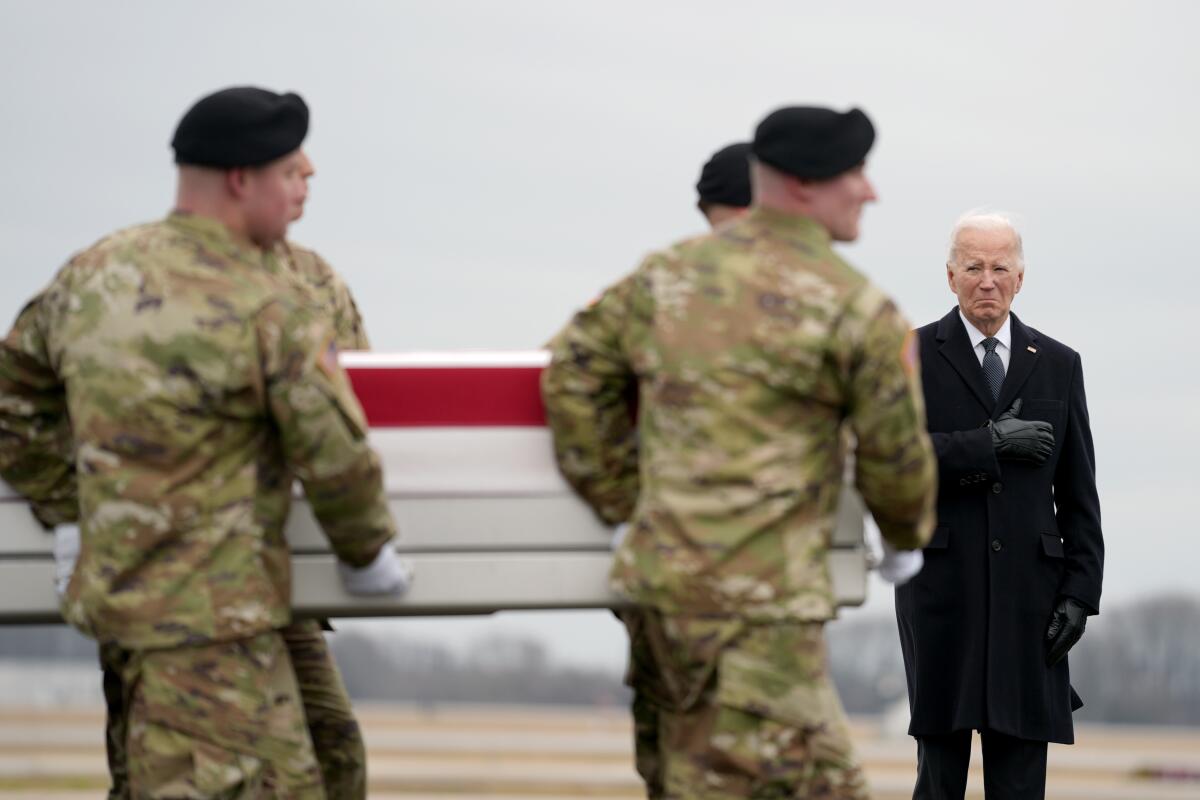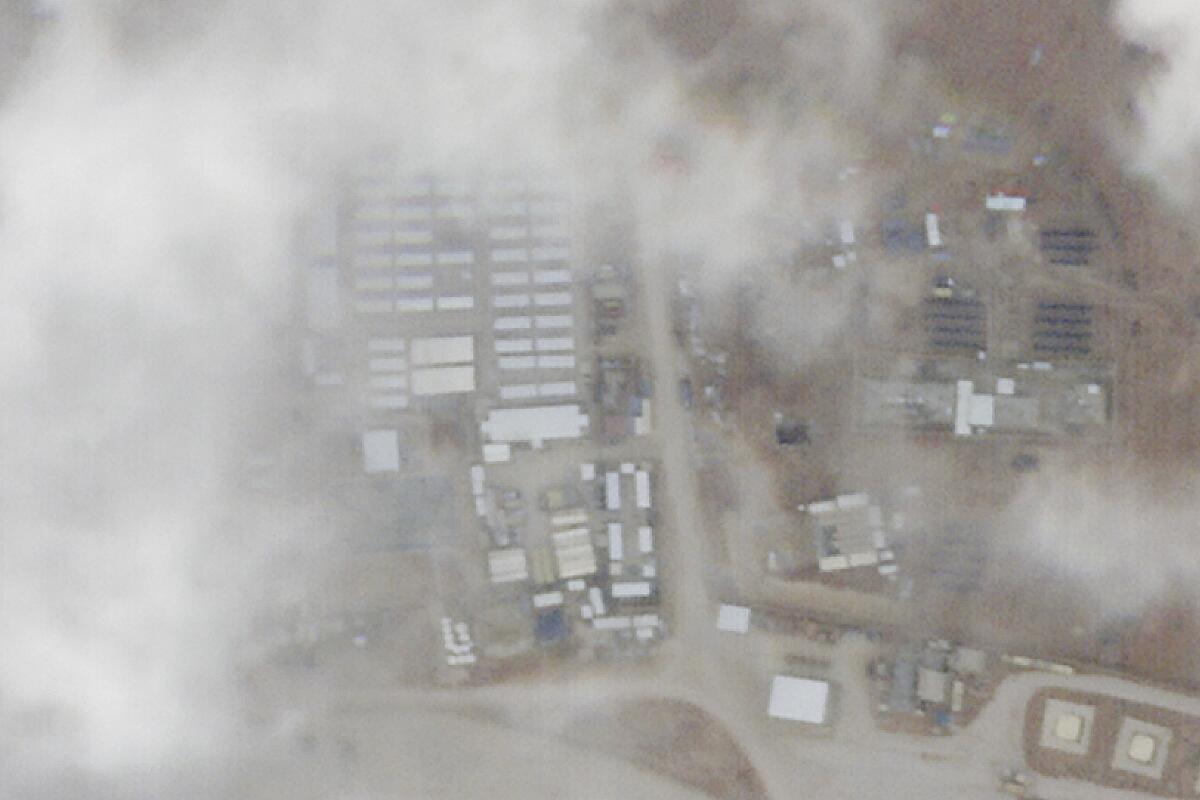U.S. launches airstrikes in Iraq and Syria, retaliating for fatal drone attack

- Share via
WASHINGTON — The U.S. military launched an air assault on dozens of sites in Iraq and Syria used by Iranian-backed militias and Iran’s Revolutionary Guard on Friday, in the opening salvo of retaliation for the drone strike that killed three U.S. troops in Jordan last weekend, according to the U.S. military and officials.
President Biden and his administration had been warning for days that the U.S. military would strike back at the militias, and they made it clear it wouldn’t be just one hit but a “tiered response” over time.
“This afternoon, at my direction, U.S. military forces struck targets at facilities in Iraq and Syria that the [Islamic Revolutionary Guard Corps] and affiliated militia use to attack U.S. forces,” Biden said in a statement. “Our response began today. It will continue at times and places of our choosing.”
The massive barrage of strikes by manned and unmanned aircraft hit more than 85 targets at seven locations, including command-and-control headquarters, intelligence centers, rockets and missiles, drone and ammunition storage sites and other facilities that were connected to the militias or the Revolutionary Guard’s Quds Force, the group’s expeditionary unit that handles Tehran’s relationship with and arming of regional militias.
U.S. Central Command said the strikes used more than 125 precision munitions, and they were delivered by numerous aircraft, including long-range bombers flown from the United States. One official, who spoke on condition of anonymity to discuss details of the operation, said B-1 bombers were used.

Two Iraqi militia officials, who spoke on condition of anonymity because they were not authorized to speak to journalists, said that three houses used as headquarters were targeted in Qaim, an Iraqi town near the Syrian border, including a weapons storage area. An operations headquarters of the Popular Mobilization Forces, a coalition of Iranian-backed militias, in Akashat, Iraq, and weapons stores were also targeted.
The assault came just hours after Biden and top defense leaders joined grieving families to watch as the remains of the three Army Reserve soldiers were returned to the U.S. at Dover Air Force Base in Delaware.
It was unclear what the next steps will be, or whether the days of U.S. warnings have sent militia members scattering into hiding, making it more difficult to detect and strike them. But it was evident that the recent statement released by Kataib Hezbollah, one of the main Iran-backed militias, saying it was suspending attacks on American troops had no impact on the administration’s plans.
The U.S. strikes appeared to stop short of directly targeting Iran or senior leaders of the Quds Force within its borders, as the U.S. tries to prevent the conflict from escalating further. Iran has denied it was behind the Jordan attack.
On Friday morning, Iran’s hard-line President Ebrahim Raisi reiterated earlier promises by Tehran to potentially retaliate for any U.S. strikes targeting its interests. We “will not start a war, but if a country, if a cruel force wants to bully us, the Islamic Republic of Iran will give a strong response,” Raisi said.
In a statement this week, Kataib Hezbollah announced “the suspension of military and security operations against the occupation forces in order to prevent embarrassment to the Iraqi government.” But Harakat al-Nujaba, one of the other major Iran-backed groups, vowed Friday to continue military operations against U.S. troops.
The U.S. has blamed the Islamic Resistance in Iraq, a broad coalition of Iran-backed militias, for the deadly attack in Jordan, but has not yet narrowed it down to a specific group. Kataib Hezbollah is, however, a top suspect.
Some of the militias have been a threat to U.S. bases for years, but the groups have intensified their assaults since the start of Israel’s war with Hamas after the Oct. 7 attack on Israel that killed about 1,200 people and saw 250 others taken hostage. The war has led to the deaths of more than 27,000 Palestinians in the Gaza Strip, the Health Ministry there says, and has inflamed the Middle East.
Iran-backed militia groups throughout the region have used the conflict to justify striking Israeli or U.S. interests, including threatening civilian commercial ships and U.S. warships in the Red Sea region with drones or missiles in almost daily exchanges.
Speaking to reporters on Thursday, Defense Secretary Lloyd J. Austin III said that “this is a dangerous moment in the Middle East.” He added, “We will take all necessary actions to defend the United States, our interests and our people. And we will respond when we choose, where we choose and how we choose.
“At this point, it’s time to take away even more capability than we’ve taken in the past,” Austin said.
As of Tuesday, Iran-backed militia groups had launched 166 attacks on U.S. military installations since Oct. 18, including 67 in Iraq, 98 in Syria and now one in Jordan, according to a U.S. military official. The last attack was Monday at Asad Air Base in Iraq, and there were no injuries or damage.
The U.S., meanwhile, has bolstered defenses at the base in Jordan that was attacked by the Iran-backed militants Sunday, according to a U.S. official.
And the Israeli military said its Arrow defense system intercepted a missile that approached the country from the Red Sea, raising suspicion it was launched by Yemen’s Houthi rebels. The Iran-backed rebels did not immediately claim responsibility.
A U.S. official also said the military had launched additional self-defense strikes in Yemen on Friday against Houthi targets deemed an imminent threat. Al Masirah, a Houthi-run satellite news channel, said that British and American forces conducted three strikes in the northern Yemeni province of Hajjah, a Houthi stronghold.
While previous U.S. responses in Iraq and Syria have been more limited, the attack on Tower 22, as the Jordan outpost is known, that killed U.S. three service members has crossed a line, the official said.
That drone attack, which also injured more than 40 U.S. service members — largely from the Army National Guard — was the first to result in U.S. combat deaths from the Iran-backed militias since the war between Israel and Hamas broke out. Tower 22 houses about 350 U.S. troops and sits near the demilitarized zone on the Jordan-Syria border. The Iraqi border is 6 miles away.
Also Friday, the U.S. Treasury imposed new sanctions on a network of firms in Iran and Hong Kong accused of assisting Iran to procure technology to make ballistic weapons and drones. And the U.S. hit six Iranian officials with sanctions for allegedly committing a series of malicious cyber activities against crucial infrastructure in the U.S. and other nations.
More to Read
Sign up for Essential California
The most important California stories and recommendations in your inbox every morning.
You may occasionally receive promotional content from the Los Angeles Times.










